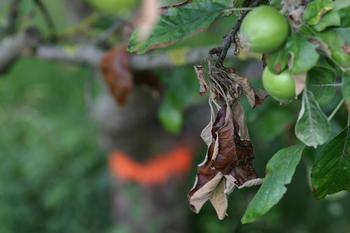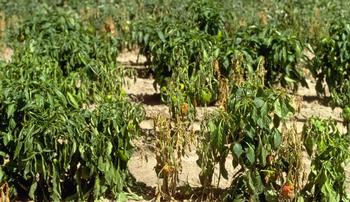Control disease spread in your garden
-
Marty Nelson
-
During the COVID-19 pandemic we’ve heard a lot about controlling the spread of infectious diseases in humans. How often do we consider that some of the same principles can be applied in our gardens? Fungi, and micro-organisms such as bacteria, and viruses are major pathogens in plants as they are in humans, and they employ some of the same mechanisms of infection. For example, spores produced by fungi can become airborne and carried from one plant to another by wind or insects. Moisture from rain and irrigation can transmit micro-organisms among susceptible garden plants and many diseases can be spread by direct contact with contaminated garden tools. While masking, rapid-testing, and hand sanitizers are not options, there are practical steps for controlling contagion in your garden.
 Brown, scorched-looking leaves are symptoms of fire blight in trees in the apple and pear family. Photo: Sebastian Stabinger
Brown, scorched-looking leaves are symptoms of fire blight in trees in the apple and pear family. Photo: Sebastian StabingerFor disease to occur, their first needs to be a pathogen present, secondly, a susceptible host plant, and finally, favorable environmental conditions. It’s impossible to eliminate potential pathogens from your garden. Micro-organisms abound in the environment and while some can cause disease, many are beneficial and important to plant health. Reducing plant susceptibility and controlling environmental conditions should be the focus of your disease prevention efforts.
Healthy plants are resistant to infection. Attention to your plant’s basic needs for water, sunlight, nutrients, and protection from injury is key. When plants become stressed, damaged, or weak, they are vulnerable. Monitor your plants’ health and watch for any symptoms or signs of disease. Plant diseases tend to spread over time, so gradual discoloration, leaf droop, or die back should prompt further investigation. Are the symptoms present on one part or the whole plant? Are neighboring plants of the same species affected? It’s often difficult to know at first whether the problem is biotic or infectious versus abiotic or due to physical conditions. In some cases, as with powdery mildew, it’s possible to see the tell-tale signs of fungal infection in the whitish spores on leaves. On the other hand, while the bacteria causing fire blight are not visible, the typical appearance of brown, scorched – appearing leaves on pear tree branches is a symptom of disease. Several species in the Phytophthora genus cause crown and root rot in many landscape and garden plants. At first the wilting leaves may appear as though the plant needs water, but as the symptoms spread, the damage to the plant becomes obvious. Because a particular plant disease usually affects a single species, the lack of spread to other types of garden plants is also suggestive of disease. The drooping and dying foliage on these pepper plants is symptomatic of Phytophthora root rot. Photo: Howard Schwartz
The drooping and dying foliage on these pepper plants is symptomatic of Phytophthora root rot. Photo: Howard SchwartzThere are no vaccines for plants but there are disease resistant varieties. When you choose plants that are certified virus free or labeled as resistant to common plant diseases, there is no longer a susceptible host for those pathogens. Fungicides and bactericides can help in reducing host susceptibility in some plants but use these cautiously to avoid harm to other plants and beneficial organisms.
Eliminating favorable environmental conditions is your first line of defense. Most plant pathogens love moisture so good soil drainage and appropriate irrigation will reduce the wet conditions they favor. Splashing water can enable micro-organisms in the soil to move up onto plants. While you can’t prevent this happening when it rains, you can avoid overhead watering.
Sanitation is key in reducing disease spread in your garden. Clear out dead leaves and debris to eliminate places where pathogens can shelter and multiply. Prune off diseased areas on plants. If the entire plant is involved, remove it. Since almost all plant diseases are killed by commercial composting, dispose of infected plants in your green bin, not your home compost pile. Sanitize gardening tools used in caring for diseased plants. A solution of 10% chlorine bleach or 70% alcohol can be used to disinfect garden equipment. Soak cleaned tools in sanitizing solution for 30 minutes before using them on uninfected plants.
An excellent source of information on identifying and managing plant diseases can be found on the UC Integrated Pest Management website at ipm.ucanr.edu.


